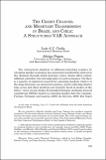Artículo
The credit channel and monetary transmission in Brazil and Chile: a structured VAR approach
Fecha
2011Resumen
The widespread adoption of inflation-targeting regimes by emerging market economies has generated considerable interest in the channels through which monetary policy shocks affect output inflation and other relevant aggregates in such economies. Yet there is a paucity of empirical research for emerging markets relative to the large literature on advanced countries partly reflecting shorter time series and other problems not typically faced in studies of the latter. A few recent studies fit standard dynamic stochastic general equilibrium (DSGE) models to emerging market data (for example Furlani Portugal and Laurini 2008 da Silveira 2008 Del Negro and Schorfheide 2008) but they largely ignore some key structural features of emerging markets in the chosen specification. Moreover the Bayesian methods used for estimation in these studies often impose strong priors so that the empirical investigation is less about discovery than about quantifying the parameters of some prescribed model. This is not to deny that DSGE models are useful for thinking about interrelationships in the macroeconomy. Nevertheless they are often best used as a source of structural information that provides a skeleton with which investigators can organize the data rather than imposing the model on the data at least until one is sure that it is a good representation of the data. Often the only way DSGE models are judged is by comparing the results to a vector autoregression (VAR) but this is unlikely to be a very powerful test. Simple checks such as whether the model’s assumptions about expectations and shocks are consistent with the data are far more likely to reveal deficiencies in the specification.
Colecciones
Descargar


